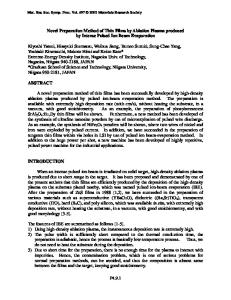Nanocrystalline diamond films prepared by pulsed electron beam ablation on different substrates
- PDF / 559,678 Bytes
- 8 Pages / 584.957 x 782.986 pts Page_size
- 18 Downloads / 353 Views
Omar Alshekhli Jubail Technical Institute, Saudia Arabia
Matiar Howlader and Jamal Deen Department of Electrical and Computer Engineering, McMaster University, Hamilton, Ontario L8S 4K1, Canada (Received 12 June 2015; accepted 3 August 2015)
Nanocrystalline diamond films have been deposited by pulsed electron beam ablation from a single target and on different substrates at room temperature and under argon background gas at 0.5 Pa. The films have been deposited from a highly ordered pyrolytic graphite target on four different substrate materials, which include silicon, stainless steel, sapphire, and cubic boron nitride. Based on experimental measurement data, obtained from various analytical techniques, it has been observed that sp3 bonded carbon content, grain size, film roughness, and nanocrystalline fraction of the films do not seem to be much affected by the type of substrate material used. The thickness of the films, in the range of ;70–90 nm, seems to be relatively the same irrespective of the substrate material. Hardness measurements have shown that film hardness, ranging between 18.5 and 19.5 GPa, is not remarkably influenced by the type of substrate material.
I. INTRODUCTION
Nanocrystalline diamond (NCD) films have many attractive properties, drawn from those of diamond whose exceptional properties are unsurpassed, suggesting many opportunities for application in a broad range of areas, such as optics, tribology, biomedicine, conformal coatings, and catalysis.1–3 NCD is a nanocomposite material consisting of nanometer-sized diamond grains (or crystallites), which are surrounded by an amorphous carbon matrix.4,5 The diamond grains contain sp3 hybridized carbon–carbon bonded atoms only, while the amorphous carbon phase consists of both sp3 (diamond-like) and sp2 (graphitic) hybridized carbon–carbon bonded atoms (and possibly hydrogen, in case of deposition in a hydrogenrich atmosphere). Depending on the preparation method and conditions (especially in the presence of hydrogen), the amorphous carbon matrix fraction can be as high as 10% of NCD film volume or lower than 5%, resulting in almost pure NCD films.1,6,7 The fraction of carbon atoms within the grain boundaries is inversely proportional to the radius of the diamond grain, assuming spherical grains.7 For instance, a fraction of 10% of nondiamond carbon associated with an average crystallite size of 5 nm is reduced by tenfold, i.e., 1%, for a grain size of 50 nm.
Contributing Editor: Mohd Fadzli Bin Abdollah a) Address all correspondence to this author. e-mail: [email protected] DOI: 10.1557/jmr.2015.254
NCD thin films have been prepared mostly using the chemical vapor deposition (CVD) method and variations thereof.8,9 More recent works using CVD include Refs. 6, 7, and 10–14. Other deposition methods have been reported as well, such as pulsed laser deposition,15,16 ion beam evaporation,17 sputtering,18 and, very recently through our own efforts, the relatively novel pulsed electron beam ablation (PEBA). 19,20 Most of the works have reported on NCD grown on
Data Loading...








